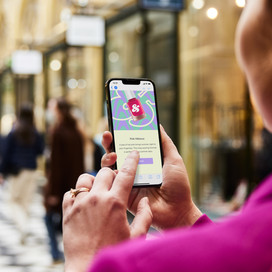Table of contents
Digital marketing refers to the promotion of brands for the purposes of connecting with potential customers via digital means. This includes using websites, social media, search engines, e-mail and mobile applications to achieve marketing objectives such as increasing brand awareness, generating business leads and converting them into customers.
Internet marketing is more important for business owners now more than ever before. According to Think With Google, 49% of shoppers say they use Google to find a new product. The same report found that 60% of smartphone users contacted a business directly using those search results. The global e-commerce market is also expected to grow by the US $1 trillion by 2025.
But digital marketing is a complex and multifaceted system of channels. In order to take advantage of its benefits, business owners must put together cohesive and well-planned strategies based on rigorous market research and the most up-to-date customer data. Below, we’ll delve deep into the world of digital marketing and outline its various types, benefits and what effective steps you can take as part of your marketing strategy.
Benefits of digital marketing
More and more business owners are beginning to realise the sheer number of advantages that digital marketing presents. According to a recent 2021 survey by fundera, 96% of business owners say they used social media as part of their marketing strategy, while 92% think that owning a website is the most effective digital marketing strategy.
Below, we’ll outline precisely why so many business owners are turning to online digital marketing to develop their brand, connect with their customers and become the thought leaders their customers are looking for when they’re ready to buy.
Target the right market
One of the greatest benefits of digital marketing is the precision with which businesses can target their market. There are many companies around the world who approach their marketing from guesswork – throwing something at the wall to see what sticks. But digital tools and internet algorithms are now able to identify with incredible accuracy what people are doing online and what their demographics are.
Digital marketers can use this data to offer users specific products or services that they may be interested in. For instance, once a visitor clicks on a brand’s display ad, whether on social media or through a search engine, the brand can target that visitor with subsequent and related ads. A user may click on an ad for fish food, and then suddenly see a whole bunch of Facebook or YouTube ads promoting different types of fish products.
The great thing about targeted internet marketing is that you’re able to target your audience with very specific products and service offerings, or content based on exactly where they are on the buying journey. For example, a business owner can use email marketing (which we’ll discuss below) to effectively ‘nurture’ a potential customer until they are ready to take action and buy. They might have consistently been exposed to your content over a period of time, or perhaps watched videos you’ve posted on YouTube. Afterwards, they’ll visit your website and give you their email address, allowing you to hit them with an irresistible offer you’ll know that they’ll likely take on board.
Increase your customer loyalty
It’s more expensive to attract and convert a brand new customer than it is to keep an existing one. That’s why, if you can maintain a good degree of customer loyalty through communicating frequently, you’ll be more likely to sell products and services to customers who know who you are. Harvard Business Review says that, if you can increase your customer retention rate by 5%, your profits could increase from 25% to 95%.
Some tactics you can use to communicate include things like personalising your emails, frequent relevant social media engagement and regularly publishing content on a useful content-rich blog.
Engage customer at all buying stages
The beauty of digital marketing is that you can track each and every step that your leads and customers make. You can do this from the point when a lead is psychologically triggered to find a particular product or a solution, to a problem they are experiencing, all the way up to when they go through your checkout page on your website to buy your product.
To get a sense of this customer journey. Imagine somebody sees an ad online for a service to remove scrap metal. That customer then searches for different options and compares prices on different websites. They find your business, go directly to your website and suss out your scrap metal removal services. They’re doing this on their mobile phone and are in the process exposed to coupons, different special offers and comparison tools. You can follow each and every step of this journey and build your marketing strategy accordingly.
Build a consistent pipeline
Another excellent benefit of digital media marketing is the ability to create a ‘sales funnel’. A ‘sales funnel’ is a system designed to create regular and consistent leads from online traffic – converting complete strangers into high-paying clients or customers. The point is to divide those who are just ‘browsing’ to actual buyers.
At the top of the funnel is your lead generation machine. This is how your leads become aware that you exist. It can be through SEO, videos, email marketing, white papers and more. The next stage, as your customer moves down the funnel, is lead nurturing through effective content marketing (which we’ll discuss below). This puts them into the position to buy your product, when they are finally ready.
Boost conversion rates
Digital marketing allows you to boost your conversion rates by consistently optimising your sales funnel. You can do this by monitoring the customer journey and making changes accordingly. You can’t really do this through traditional print marketing. After all, how do you know if somebody physically saw your ad in a newspaper (or even on television) and then went to the store to buy it? You don’t. But you can see this through digital marketing.
Measure results accurately
When marketing offline, it’s hard to measure the results of your campaigns. You’ll never really know how many people saw a billboard, or a newspaper. It causes frustration because you won’t know if your efforts are effective. But this is different from digital marketing, where you can literally measure anything that’s worth measuring. Everything from when your ads are clicked, (whether that be on Google or YouTube) and your emails are opened, to when your customers leave your website.
Types of digital marketing
So you understand the digital marketing benefits you can potentially reap, but what are the different types of digital marketing? The answer is that there are so many different kinds of marketing and you can often get overwhelmed. We’ll outline what they are briefly below.
1. SEO
Search engine optimisation (SEO) refers to optimising your online content so that it can be identified by search engines, and appear on search engine results pages (SERPs) when people search a particular query or keyword. For example, if you type ‘dog friendly cafes near me’, the local businesses that have invested in SEO will most likely appear on the very first page of Google (and therefore, their intended customers – dog owners – will be more likely to go there and buy a coffee).
SEO is a vital piece of the digital marketing puzzle for today’s business owners. Over 50% of shoppers say they use Google to find a new brand.
2. Content marketing
Content marketing is about increasing your brand awareness and creating confidence in your customers that you are an expert and the leader in your field. Your customers out there are desperate for information about how to solve their most burning problems or fulfill their deepest desires. You can show your customers you know what you’re talking about in so many ways, ranging from blog posts,social media posts, to email campaigns and YouTube videos.
3. Email marketing
Millions of emails are sent every single day, yet some people still (for some reason we can’t quite understand) think email marketing is a thing of the past. This has never been further from the truth. Emails are not only a great way to execute your content marketing campaign, but also by promoting special offers and deals as part of our sales funnel.
4. Social media marketing
Social media marketing, as the name very clearly indicates, refers to using social media to promote content, your products, services and brand. You can do this by making free posts, or through paid ads. Either way, it is important to choose the best type of social network for your brand. You’ll typically market a lot differently on LinkedIn than you would on Facebook, Instagram or TikTok.
5. Affiliate marketing
Affiliate marketing is where producers of content are paid to promote a service. They act like third party marketers who are there to build your brand awareness and create leads to help you get your product or service out there. Every lead they provide you, they get paid.
For example, a very popular dog blogger with thousands of followers may also be an affiliate marketer. You may decide to approach them to sell your incredible new dog bed. If they describe and promote it on a blog post that’s viewed by thousands of readers, they may very well generate leads for you who will then enter your sales funnel.
6. Marketing automation
Marketing automation refers to placing your marketing on ‘autopilot’. That way, you don’t have to worry about consistently sending out emails, posting on social media, writing blog posts or doing any of the marketing side of your business.
Square Marketing, for example, is a great way to create, send and track email marketing campaigns in a matter of minutes. You can easily design emails and put together automated campaigns from a central dashboard.
7. Mobile marketing
Optimising your strategy for mobile is one of the most important pieces of the marketing puzzle that all owners must adopt. There are over 5 billion mobile phone users globally. Around 40% of all online transactions occur on a mobile, and people are even over 60% less likely to buy something if they’ve had a negative experience on their mobile.
8. Paid advertising
Paid advertising is an effective form of digital media marketing when done right. You can create paid ads on Facebook, Instagram and LinkedIn, while also publishing paid ads on Google that can appear on top of the SERPs. They’ll always, however, come with a logo such as “Ad”, “Sponsored” or “Promoted” so users are aware that they are watching an ad. There are different ways to pay for online ads, but the most common are Pay Per Click (PPC) and also Cost per Mile (CPM).
9. Instant message marketing
Direct instant messaging is a great tactic to incorporate into your marketing strategy because you can directly target leads through SMS, Facebook, LinkedIn, WhatsApp or Telegram. You could, for instance, create a unique VIP-only text community where you offer special deals and promotions to customers who’ve signed up to that list. Pizza Hut found that its SMS marketing was 142% more effective than its other channels when it came to increasing sales, after trialling a 15-month SMS campaign in the United Kingdom.
10. Influencer marketing
Influencer marketing means promoting your brand, products or services through a digital ‘influencer’. This is somebody, typically on a social media account, who boasts a massive audience of people that qualify as attractive leads to your business. You may – for example – be selling a new make of dog kibble, and perhaps team up with a pet influencer to get the message out and promote your product.
Top 10 digital marketing tips
1. Automate your tasks
If you want to focus on your core business rather than being bogged down on sending promotional emails, making Facebook posts and writing blog posts, then the key is to automate your tasks so you don’t have to worry. Programs like Square Marketing can help you set this in motion by automating your email campaigns.
2. Use the right marketing tools
There’s no point building an effective online digital marketing strategy if you don’t have the tools to action the magic. Whether this be keyword research tools or customer relationship management (CRM) software, you should invest in the right programs to make sure your strategy helps you achieve your business goals.
3. Optimise your Google My business listing
Creating a “Google My Business” listing is free and easy. It is a very quick way for Google to recognise that your business exists and creates a tab on the right-hand side of the SERPs to show all your business’ details from the address and hours to the phone number and website. It’s also a way for customers to leave Google reviews, something which many users look at when deciding to purchase a product or service.
4. Combine your SEO and marketing
Through combining your content marketing with an SEO strategy, you can make sure that all content you produce (such as blog posts or videos on YouTube) can be found when people are searching for them.
5. Optimise for mobile
As we’ve said above, optimising for mobile is one of the most important actions a business owner must take in the modern world of digital media marketing. If your website and sales funnels are not user friendly, then you’ll be missing out on a large chunk of potential customers.
6. Become a design genius
Building an amazing brand means you should really know how to design – ideally, become a design genius. You don’t need to be Picasso in order to do this. Software does exist to help you become a better designer, such as Canva and Photoshop.
7. Always watch your analytics
It can be very easy to set your digital marketing campaign into action and then forget about it. But this will only be a recipe for failure. The key is to constantly monitor how your campaign is performing and optimise it as you go. You can do this through programs like Square Analytics.
8. Pay money for digital advertising
While there are a lot of good free online digital marketing options out there, such as SEO and social media posting, paying for advertising is something you should seriously consider investing in. While may stagger through it unsuccessfully and do it wrong, a robust paid advertising strategy can certainly pay off dividends. The key is not simply to promote your product, but to showcase the solution or the desire that your customers are craving.
9. Use social media to keep customers happy
If your business is active on social media, use it to keep your customers happy. Places like Facebook and Instagram can be a very easy place for your customers to go and vent, whether it be due to a poor customer service experience or a delayed package. The key is to immediately respond to these complaints publicly, showing the world that you are committed to providing high-quality customer service every step of the way.
10. Chase your abandonments
If you’re running an e-commerce store, you’ve likely come across the experience of a customer loading their shopping cart full of products they want and then abandoning it. There are many clever tactics you can use to reduce your cart abandonment rate, ranging from chasing them down to downselling your products.
![]()











